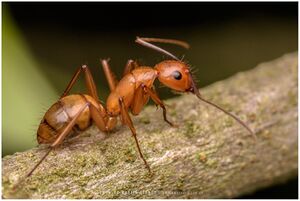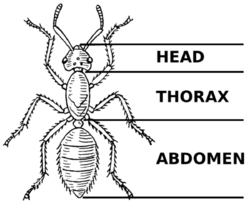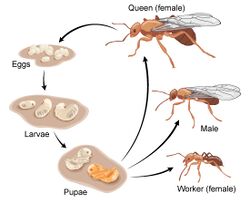Formicidae: Difference between revisions
No edit summary |
No edit summary |
||
| Line 41: | Line 41: | ||
== Life Cycle == | == Life Cycle == | ||
[[File:LifeCycle.jpg|250px|thumb|right]] | [[File:LifeCycle.jpg|250px|thumb|right]] | ||
Formicidae go through four basic life cycle stages in which there are three end results. Ants begin as eggs that are laid by the female queen. They then begin to go through complete metamorphosis, going through four or five larval stages. They are largely immobile during the larval stages and rely on worker ants to eat. In the earlier larval stages, they are provided with liquid food regurgitated by the workers. In the later larval stages, they will begin to be provided with more solid foods, such as pieces of prey, seeds, and trophic eggs. At the end of the larval stages, the ants will emerge as pupae, and the differentiation of the ants into the different castes will begin. If the original egg was not fertilized, the pupa will emerge as a winged male haploid drone. If the original egg was fertilized, the pupa will emerge as either a winged or wingless female diploid queen or a wingless female diploid worker. Whether the female becomes a queen or a worker largely depends on how much nutrients the ant receives during the larval stages. [1] | |||
Female queens can live up to 30 years. Female workers can live one to three years. Male drones typically only live for a few weeks. [1] | |||
== Effects on Soil == | == Effects on Soil == | ||
Revision as of 11:49, 22 April 2023
Overview

Formicidae is a family, containing ants, that belongs to the order Hymenoptera, which contains the ants close relatives bees and wasps. It's estimated that there are 22,000 species of ants, with roughly 15,000 of these species being classified. [1] They are incredibly numerous, being found everywhere in the world except for Antarctica as well as Greenland, Iceland, Hawai'i, and some Pacific Islands that don't have native species. [2] The mass of all the ants in the world is said to be greater than the mass of all birds and mammals combined, with an estimated human-to-ant ratio of 1:2,500,000. [3]
Taxonomy
- Kingdom- Animalia (Animals)
- Phylum- Arthropoda (Arthropods)
- Class- Insecta (Insects)
- Order- Hymenoptera (Ants, Bees, and Wasps)
- Infraorder- Aculeata (Ants, Bees, and Wasps)
- Superfamily- Formicoidea (Ants)
- Family- Formicidae (Ants)
- Superfamily- Formicoidea (Ants)
- Infraorder- Aculeata (Ants, Bees, and Wasps)
- Order- Hymenoptera (Ants, Bees, and Wasps)
- Class- Insecta (Insects)
- Phylum- Arthropoda (Arthropods)
Description


Most ant species found will be either red, brown, or black in color. [2] They can range anywhere from 1/16 of an inch long (Crazy Ant) [4], up to 1.6 inches long (Dinoponera, thought to be the biggest ant species in the world, found in South America). [5] Most common ants, however, are 1/16 to 1/2 an inch long. [6] Their bodies are broken down into three main segments (Figure 1), with the thorax and the abdomen being further broken down into three more subsegments (Figure 2).
Head
The head of an ant contains the mouth, five eyes, two antennae, and two strong jaws. Of the five eyes, two (located on the front of the head) are compound eyes that are good for acute movement but do not allow for high-resolution images, while the other three (located on the top of the head) are simple eyes that detect changes in light. The two antennae are sensory organs that allow ants to detect chemicals, air currents, and vibrations, as well as receive signals through touch. The strong jaws are used for defense, carrying food, and constructing nests. [1]
Thorax
The thorax is the middle part of an ant's body. It is powerful and muscular, with each of an ant's six legs attached to it. If an ant develops temporary wings, they will be attached to the thorax as well. [7]
Abdomen
The abdomen contains all the vital and reproductive organs of the ant. If a worker ant has a stinger, it can be found on the back of the abdomen. [7]
Mesosoma
The mesosoma is the first of the three subsegments of the ant's body. It is attached to the head, and it contains the thorax plus the first abdominal segment. [1]
Petiole
The petiole is the second of the three subsegments, located between the mesosoma and the garter. It acts similar to a waist in a human, allowing the ant flexibility when twisting and aids the ant when burrowing underground. [7]
Gaster
The gaster is the last of the three subsegments of the ant's body. It contains all of the abdominal segments included in the abdomen except for the ones included in the petiole. [1]
Common Species in the Northeastern USA
- Linepithema humile (Argentine Ant)
- Ochetellus glaber (Black House Ant)
- Camponotus pennsylvanicus (Carpenter Ant)
- Solenopsis invicta (Fire Ant)
- Tapinoma melanocephalum (Ghost Ant)
- Tapinoma sessile (Odorous House Ant)
- Tetramorium caespitum (Pavement Ant)
- Monomorium pharaonis (Pharaoh Ant)
Life Cycle

Formicidae go through four basic life cycle stages in which there are three end results. Ants begin as eggs that are laid by the female queen. They then begin to go through complete metamorphosis, going through four or five larval stages. They are largely immobile during the larval stages and rely on worker ants to eat. In the earlier larval stages, they are provided with liquid food regurgitated by the workers. In the later larval stages, they will begin to be provided with more solid foods, such as pieces of prey, seeds, and trophic eggs. At the end of the larval stages, the ants will emerge as pupae, and the differentiation of the ants into the different castes will begin. If the original egg was not fertilized, the pupa will emerge as a winged male haploid drone. If the original egg was fertilized, the pupa will emerge as either a winged or wingless female diploid queen or a wingless female diploid worker. Whether the female becomes a queen or a worker largely depends on how much nutrients the ant receives during the larval stages. [1]
Female queens can live up to 30 years. Female workers can live one to three years. Male drones typically only live for a few weeks. [1]
Effects on Soil
References
[1] https://en.wikipedia.org/wiki/Ant